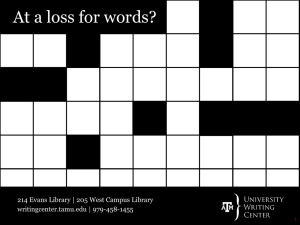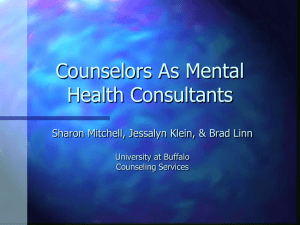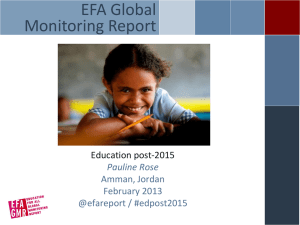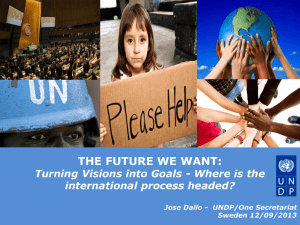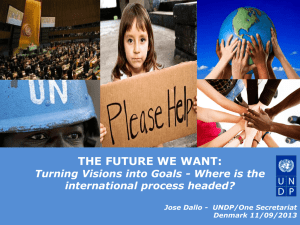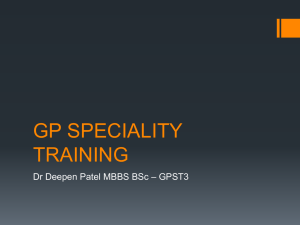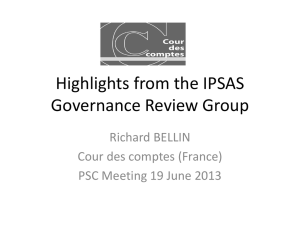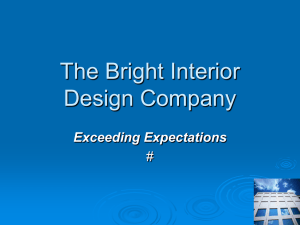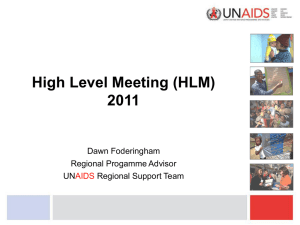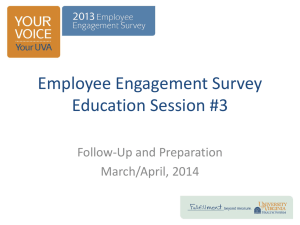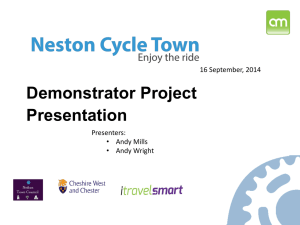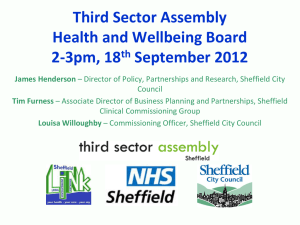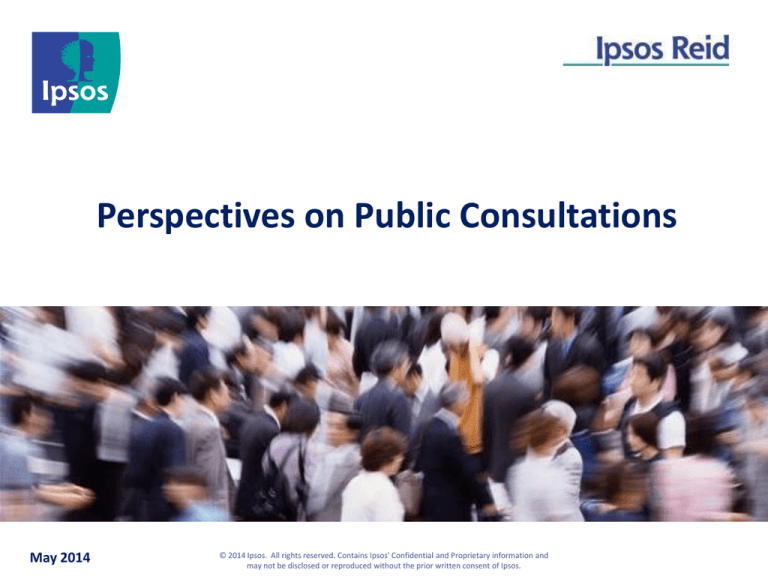
Perspectives on Public Consultations
May 2014
© 2014 Ipsos. All rights reserved. Contains Ipsos' Confidential and Proprietary information and
may not be disclosed or reproduced without the prior written consent of Ipsos.
Our view on public consultations…
Public consultations have long been a part of our business.
One of our earliest large-scale public consultations efforts took place in 1997 on behalf of the
Canadian Medical Association. In the wake of cuts to the health care system, we brought
together over 600 health system experts, physicians and the general public in a nationwide
series of conferences to exchange information and perspectives on the future of healthcare in
Canada.
What made this and other public consultations efforts succeed is the opportunity it created for a
genuine exchange of information and views, from the highly informed perspectives of experts
and professionals to the responses of members of the public now armed with a better
understanding of the issues and challenges that decision makers face.
At their best, public consultations help bring stakeholders with vastly different perspectives to a
place where, even if their views are not aligned, they can better understand each other, and –
most importantly – help our clients deliver the most optimal approaches to the most difficult
challenges they face.
At a time when more and more Canadians are having their say on public issues via social media,
we are proud to offer new and innovative ways to help our clients capture their attention and
hear what they have to say.
This report summarizes the findings of recent opinion research conducted among the general
public and the comments of a group of over 30 public consultations experts representing the
federal, provincial and municipal governments, as well as non-profit organizations.
2
What we did…
Ideation Session with Public Consultation Practitioners
Ipsos Reid recently hosted a conversation with public sector
consultations professionals to discuss the findings of recent
research on public attitudes towards consultations and their
implications on best practices.
We presented findings to a group of more than 30 Public
Consultation Practitioners including professionals representing
the federal, provincial and municipal governments, as well as the
non-profit sector on April 24, 2014.
During the presentation, participants were invited to answer
questions and provide comment through our online Ideation
tool.
Sessions included Public
Consultation Practitioners from
participating organizations:
• Federal and Provincial
Departments
• Not for Profit Organizations
• Crown Corporations
• Federal Agencies
• Professional Associations
General Public Survey Methodology
The results presented were drawn from a survey of n=1,000
interviews among Canadian adults.
Conducted online between February 20-25, 2014.
Results obtain a ±3.4 percentage point confidence interval.
For more on Bayesian confidence intervals: http://bit.ly/1i6SIjA
3
Practitioners report utilizing an on-going process of public consultations,
often conducting multiple, in-person sessions.
How many consultations/stakeholder engagement initiatives has your
organization conducted in the last 12 months?
Ongoing
process
How do you typically carry out your consultations
(mode)?
In person
Online
By other means
OneOffs
By mail
Mobile
With whom?
Stakeholder
Audiences
How many consultations/stakeholder engagement initiatives has your
organization conducted in the last 12 months?
5 or
more
Public
Clients
2 to 4
Only 1
Staff
Source: Ipsos Ideation Exchange session. Base: Public Consultation Practitioners n=22
Size/shape of illustration(s) are indicative of the proportion of mentions elicited during the Ideation sessions
conducted.
4
18% of Canadians have participated in a public consultation or town
hall to give their feedback on a public issue in the past 12 months.
… those who say they participated are more often
males and those with higher levels of education.
% Yes
Q1. Have you participated in a public consultation session or a town hall, that is, a public gathering designed
to allow citizens to give their feedback on public issues in the past 12 months? This could be an in-person or
virtual (online) meeting, a meeting sponsored by a municipal, provincial or federal government department or
agency or a meeting sponsored by another organization designed to talk about issues impacting the public.
Base: All respondents n=1,023
5
Personal interest most likely to drive participation in
public consultations.
Which of the following best describes the main
reason you participated?
Q4. Thinking back to the most recent public consultation or town hall meeting you participated in
which of the following best describes the main reason you participated? Base: All who have
participated in a public consultation session n=192
6
One in five would prefer to participate in an online public consultation.
How did you participate?
And how would you prefer to participate?
Public/Town Hall meeting
Online/social media
discussion
By mail
In person one-on-one
meeting
In person council meeting
Online Town Hall meeting
Other
None
Don't know
Q3. From the following list please indicate how you participated in this public consultation. Base: All who
have participated in a public consultation session n=192 / Q5. Which of the following would be your
preferred way of participating in such a public consultation or town hall meeting? Net of FIRST & SECOND
CHOICE to show TOTAL MENTIONS. Base: All respondents n=1,023
7
Despite limited use by practitioners, mobile offers new levels of engagement
• Today over 20% of all web traffic is via mobile and is forecasted to be 48% by 2017.
• When asked how they have used mobile in public consultations, practitioners said they
had used mobile devices in limited ways such as allowing participants to complete
surveys on iPads, promoting Twitter hashtags to generate comments and using text
messaging to solicit votes.
• New mobile consultation tools now allow for event and location-based consultations
that result in more intimate engagement with citizens (e.g. soliciting diary-style feedback
from program participants). For example, Ipsos recently used mobile consultations to
create an on-going dialogue with over 300 participants at a three day conference.
Source: SSI, Facebook News Room & Litmus (Oct 2013)
Litmus data is pulled monthly and is based off of over 300+ million email opens world wide. Real data, not claimed!
8
Most Canadians are engaging on public issues via social media, and at
least one in four see social media replacing public consultations.
25% say they don’t need public consultations because of social media…
I don't need to participate in
public consultations because I can
have my say on issues through
social media.
This proportion rises to 33% among those who say they participated in a public consultation in the past year!
47% of Canadians say they engaged on social media to get info or discuss social and public issues
at least once a week… while three in five engaged in some way every month…
13% started conversations
22%
commented or shared links
27%
read what others posted
40%
are not engaged
Q10. To what extent to you agree or disagree with each of the following statements?
Base: All respondents n=1,023
60%
9
Overall, Practitioners recognize the opportunities of using online
modes to consult with the public and stakeholders.
But who is listening in and participating in these
discussions who also has an ability to influence
policy? Put another way, are policy makers or policy
influencers actively scouting out such online
conversations to gauge what Canadians are saying.
Thinking or doing?
Do Canadians come back to a
specific social media post or is
something that was posted an
hour ago ancient history?
We monitor people who
post comments on our
Facebook and/or tweet
about us but we largely just
react to the negative
comments.
How does one filter the informed
comments from those who are just
spouting off to hear/read
themselves online?
More interested in how to leverage
social media tools – it’s generally the
‘undiscovered country’ in Government.
10
How Public Consultation Practitioners are incorporating social media into
consultations:
SOCIAL
MEDIA
(unspecified)
•
•
•
Used to promote
upcoming or current
consultations open to
public participation;
Used to facilitate remote
participation in an event;
During Public or Town
Hall events, a facilitator
will read comments
posted on Facebook.
•
•
•
•
•
Used to promote
upcoming or current
consultations open to
public participation;
Use a dedicated hashtag
for consultations series;
Supplement in-person
events with live Twitter
feed projected on-screen;
Used to facilitate remote
participation in an event;
During Public town Hall
events, a facilitator will
read comments posted
on Twitter.
•
•
Used for advertising and
promotion
Scanned in advance of
consultations to help
gain an understanding
of how issues are being
discussed.
11
Many are interested in participating in public consultations, but this
hinges on ease of accessibility.
I would be interested in participating in a
public consultation if it were easy and
convenient for me to do so.
I am too busy to participate in a public
consultation.
Q10. To what extent to you agree or disagree with each of the following statements?
Base: All respondents n=1,023
12
Practitioners recognize that convenience is key.
Practitioners recognize the need for public consultations to be inclusive and
accessible. In order to facilitate citizens, the discourse centered on whether
to improve face-to-face meetings or utilize online methods.
Face-to-face methods:
“[Use] a mix of online and in-person.”
“Providing sufficient notice to stakeholders
to facilitate increased participation.”
“They should be held on weekends
because more people are available on
weekends.”
“Need to think about being inclusive. Not
everyone has the technology (or the best
technology) and not all are comfortable
using these sorts of tools.”
Online methods:
“The city often holds public consultations,
6-8pm, in a local church. Not easy to get
to. They should probably go with more
online tools.”
“Online consultations are certainly the
easiest way.”
“…if online, they are open for many hours
to allow for maximum participation.”
“A good online tool should have a
moderation element, deletion, delayed
posting, etc. Post rules of engagement as
well.”
13
Public Consultation Practitioners hypothesized about how to encourage
citizens to participate:
This is an on-going challenge. I think
this is part of your Communications
Plan. It’s part of the education that has
to go with consultation.
…[You] need to think strategically
about how to reach them.
Some sort of outreach/Comms Plan is
sometimes needed to promote the
consultation itself.
The first step, in my view, to any
consultation is information sharing
and education about the issue.
You can engage via their association/a trusted third
party to encourage participation or by providing
background information to provide context.
14
Majority think consultations are just for show and many question
whether participation makes a difference.
I would only participate in a
public consultation if the
issue had a direct impact on
me or my family.
Public consultations are just
for show, those who put them
on rarely take into
consideration the feedback
received during these
sessions when making
decisions.
If I participated in a public
consultation I think my
contributions would have an
impact on the final decisions
made.
Q10. To what extent to you agree or disagree with each of the following statements?
Base: All respondents n=1,023
15
Most who have participated in a public consultation have had a positive
experience and hold a positive attitude towards the sponsor.
How would you describe your experience in the public consultation you participated in?
How would you describe your attitude towards the organization that sponsored the public consultation?
Those with a higher education tend to hold a more
positive attitude towards the organization that
sponsored the public consultation (68% of University
Graduates vs. 44% with High School only).
Q6. How would you describe your experience in the public consultation you participated in? / Q7. How
would you describe your attitude towards the organization that sponsored the public consultation?
Base: All who have participated in a public consultation session n=192
16
Our Normative Measures:
In addition to efforts to make consultations personal and relevant we have
normative measures built in to each session to measure participants’ reactions.
The following are standard questions asked at the end of each consultation we do…
• Today’s session allowed me to openly share my views and opinions
• I learned something interesting today
• I enjoyed taking part in today’s session
• I would participate in this type of session again
• I believe that our opinions today will have an impact on future decisions
• The (sponsor name) cares about my opinions
• The (sponsor’s name) is open and accessible
We use these questions (normative measures) in order to gauge participant’s
impressions of the consultation event they took part in.
Also, and perhaps more importantly, we make a point of comparing results from
this exercise to all of the other consultations we’ve run so that we can address any
issues and make necessary adjustments prior to holding the next session.
17
Practitioners are attuned to their obligations to the participants of public
consultations and how this can affect the participants experience.
I think you have to be sincere, listen and provide
feedback on how the results will be used. If the
consultation is just for show people see through it
and get upset.
‘Token’ engagement initiatives are seen as
disingenuous. Too many of these lead to
fatigue and makes it more difficult to
engage on meaningful activities.
I think the consultation being a positive experience is
important, but it is only truly positive if it actually made a
difference, if participants were able to read a ‘what we
heard’ report, or saw how their input factored into a
decision.
The objective of the consultation needs
to be clear and participants need to feel
that the organization is listening.
18
Questions and Answers: The Data.
Any idea on why the lower rate of participation in public
consultations among women?
Our data found that women are less likely than men to say they have participated in public consultations (13% vs.
23%). We also found that women are less likely than men to say they have engaged on social media to discuss
public issues (41% vs. 55%) and are less likely to read conventional (19% vs. 28%) or online newspapers (31% vs.
37%). Yet, women are much more likely to say they use social networks on a daily basis (70% vs. 51%). This
suggests is that women can be reached and become engaged, but more research needs to be done to find out how
this should be done.
Do you find the online nature of the survey affects the demographics
and accessing a sample?
Online penetration is greater than 80% according to the most recent Statistics Canada data, and while there is a
skew towards younger and higher income respondents, this is also true among landline telephone based studies.
The ability to pre-screen online panelists enables us to construct online samples through quotas that are much
more reflective of the public than telephone samples tend to be.
In your approach to social media research are you including blogs,
Twitter, Facebook, etc.?
In our social media research practice we conducted social listening exercises using a search tool that enables us to
scan the publicly accessible universe of social media activity. This includes primarily Twitter, blogs, and publicly
accessible comments on news websites. It also includes publicly accessible Facebook activity, although most of this
activity happens on private user accounts which we cannot access. Our approach looks at social media data as
universe like others that has limitations on what can and cannot be sampled.
19
Questions and Answers: The Data.
How do you help people realize that the issue/policy/ program will have a
direct impact on them, particularly when it is a long-range issue?
Great question – in our experience the best way to do this is to find a way to make it real for them. In some cases
you need to think outside the box and present stakeholders with real-life type scenarios which illustrate how issue
X could affect population Y in a given circumstance.
When is it okay to not have participation/consultation?
Our view is that engaging your constituency is always a good idea – that said, there are many ways to engage
your audience in a conversation so that they feel valued. Organizations who neglect to recognize this do so at their
own risk and peril. It is however important to recognize that conducting consultations necessarily creates
expectations so it is of utmost importance that you manage these expectations effectively so as to ensure
participants leave feeling like the experience was a positive one.
Are you ever worried about providing too much information or
skewing the input?
With any consultation it is important to take a measured approach when providing stakeholders with information
– providing too much may overwhelm or overburden, too little and you may create a sense that your
organization is not being forthcoming. In our opinion, it’s more about the quality of the information you
disseminate as well as your ability to convey this information succinctly.
20
Questions and Answers: Ideation Exchange Platform.
Do you use this tool for consultations?
Does this tool work in person or is it just used
online?
Yes, we regularly use the tool when conducting consultations
on behalf of our clients.
In our experience the tool works just as well in an in-person
type setting as it does online. The ability to ensure comments
are not attributed (if clients so choose) means that
acquiescence bias and social desirability factors can be
effectively minimized.
Do you have to have a log in or can it just be
open to anyone?
Users are required to login in order to participate in these
types of sessions. We typically distribute login and password
information via an email sent to potential users in the days
leading up to the event. When conducting sessions in an inperson type setting, login information is communicated at the
outset of the session.
Can this tool be used to keep the conversation
going after the ‘formal’ discussion is done?
We can certainly extend the active discussion beyond
completion of the facilitated event, allowing participants to
contribute in the hours/days following the session.
Do you have a different tool for the Bulletin
Board approach?
The ideation platform can be used for relatively short sessions
as well as in a bulletin board type scenarios – we recently used
it to enable a week long bulletin board discussion among
public sector elites.
21
Thank you!
Ipsos would like to extend our thanks to all those who
participated in the Ideation Exchange session conducted to
support this research.
For more information, please contact:
Will Daley
Vice President
Ipsos Reid Public Affairs
Marc Beaudoin
Vice President, Qualitative Hothouse
Ipsos Reid Public Affairs
1 Nicholas Street, Suite 1400
Ottawa, ON, K1N 7B7
Phone: (613) 688-8979
Email: will.daley@ipsos.com
1 Nicholas Street, Suite 1400
Ottawa, ON, K1N 7B7
Phone: (613) 688-8973
Email: marc.beaudoin@ipsos.com
© 2014 Ipsos. All rights reserved. Contains Ipsos' Confidential and Proprietary information
and may not be disclosed or reproduced without the prior written consent of Ipsos.
22

